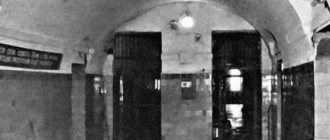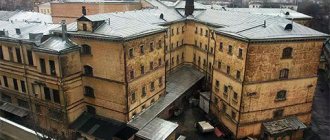The Federal Penitentiary Service (FSIN) of Russia has decided to close Butyrka, the largest investigative prison in Moscow, one of the oldest and most famous in the country. Over its more than two-century history, fighters against tsarism, Bolshevism, and victims of Stalin’s repressions managed to visit there. In the tower, where the leader of the peasant revolt, Emelyan Pugachev, once languished, mass executions of enemies of the people were carried out, and in the dashing 90s, criminal authorities feasted there. The main prison of Moscow has survived two empires and, it seems, has seen everything. The history of the legendary Butyrka was remembered by Lenta.ru.
Butyrka prison: where is it located?
Butyrskaya prison is located in Moscow, on Novoslobodskaya street, 45. Officially, this is the pre-trial detention center of the Federal Penitentiary Service of the Federal Penitentiary Service of the Russian Federation.
Like many other Moscow prisons, Butyrka was often overcrowded. The prisoner detention regulations set a limit of 2,000, but in practice there are up to 3,500 prisoners. Currently there are about 2,500 prisoners in Butyrka.
Butyrka does not have its own official website, but it has an email ( [email protected] ) and telephone numbers:
- +7 – head of the detention center, Colonel S.V. Telyatnikov;
- +7 – pre-trial detention center helpline;
- +7 – helpline of the FSIN management.
Letters to Butyrka can be written to the address 127055, Moscow, Novoslobodskaya 45.
The number of letters and parcels is not limited, since not only convicts, but also persons under investigation are kept in the detention center. But all shipments are registered, so their receipt by recipients is often delayed.
It must be remembered that if prohibited items are found in a parcel, the sender may be subject to administrative or criminal liability.
Prison range
Despite the fact that in the 21st century the truly terrible times in the history of Butyrka are a thing of the past, the conditions of detention for prisoners there still leave much to be desired. In 2008, arrested businessman Alexei Kozlov, in collaboration with his wife, journalist Olga Romanova (now the founder of the Sitting Rus' movement), began publishing his prison diaries on the Internet under the name “Butyrka Blog”.
“The fact that it is very cold in the cell does not make any impression on anyone. There are no questions about where we store the products that relatives give us. No one asks how we dry things, or how we manage to open a window that doesn’t have a single handle,” Kozlov wrote about the conditions in the pre-trial detention center.
Butyrsky pre-trial detention center (top view)
Photo: Anton Denisov / RIA Novosti
In a conversation with Lenta.ru, human rights activist Vladimir Osechkin says that Butyrka, built in tsarist times, despite its historical value, has long been absolutely unsuitable for holding prisoners.
“In the detention center, basic sanitary standards are not observed to ensure a normal standard of living for prisoners - no amount of cosmetic repairs will save you from this,” he says. — In most cells there is no hot water, normal heating, a latrine, especially in large cells, one for 10-40 prisoners. Many people there become seriously ill.
However, despite such terrible conditions, the jailers, according to Osechkin, tried out more than one know-how in Butyrka in their own interests. In particular, it was the main pre-trial detention center in Moscow that became the place where they first began to use jammers and the latest electronic systems to block prisoners’ mobile communications.
Admission schedule and conditions
Relatives are allowed to visit prisoners once every two months for four hours.
The date takes place in the constant presence of a guard, and any contact, be it a handshake or a hug, is prohibited.
No more than two adults are allowed per visit. The number of minors is not limited. There is also no limit on the number of visits to a lawyer.
Prisoners who are on a light regime, as well as on a general regime, can get a long visit in a hotel-type room. Room rent is paid, and the frequency of meetings is once every 2 months. For the general regime - once every three months. Meetings start at 9 am. The place is located within walking distance from the Mendeleevskaya, Novoslobodskaya and Savelovskaya metro stations.
Sergei Pavlovich Korolev
In the late 1930s, the brilliant rocket designer Sergei Pavlovich Korolev ended up here. During one of the interrogations, his jaws were broken, forcing him to sign a confession of sabotage. The investigator hit him with the decanter on his cheekbone with all his might. Because of this, the scientist subsequently experienced difficulty eating and could not open his mouth wide (due to unsuccessful bone fusion). The same circumstance led to his death on the operating table: during the process it was necessary to insert a tracheal tube into his throat, but due to the design of the jaw, correct insertion of the tube turned out to be impossible. The great scientist’s heart stopped 30 minutes after the start of the operation...
Prison photo of S.P. Queen
Peculiarities
Perhaps the main features of “Butyrka” are its glorification in culture, as well as the size of the cameras. This prison is mentioned in numerous films, books, and songs.
Since many prisoners were kept in large cells at the same time, stable connections were formed between them. Thus, contrary to the logic of imprisonment, Butyrka contributed to the development of many criminal groups. Their joint actions continued in the wild.
Since 1996, women have stopped being sent to this pre-trial detention center. The exception is when they undergo a psychiatric examination in a small clinic on the territory of the prison.
Makhno
From 1911 to 1917, Nestor Makhno was imprisoned in Butyrka prison. He was released as a political prisoner in 1917 during the February Revolution. Since 1906, Makhno was a member of the association of peasant anarchists and actively participated in terrorist attacks and robberies of the “rich.” In 1908, he was arrested for the murder of a military official. At first he was sentenced to hanging, which was later replaced by indefinite penal servitude. He served his sentence in the convict department of Butyrka. Being semi-literate, he was actively engaged in self-education in his cell: he studied history, literature, and mathematics. He also repeatedly took part in prison protests, for which he often ended up in a punishment cell and eventually earned himself pulmonary tuberculosis.
History of Butyrka prison
“Butyrka” traces its history back to the time of Catherine the Second. At that time the prison was made of wood, and gained fame due to the detention of Emelyan Pugachev in it. After the construction of the stone prison in 1879, one of its towers was named Pugachevskaya.
The project of a stone prison with four towers and a temple in the center was created by the architect M. Kazakov. This building still stands today. The church has also been preserved.
Since 1868, “Butyrka” became a transit prison, where convicts for hard labor in Siberia were formed. At that time, a hundred or more people were kept in cells at a time. There was a special room in the prison for the wives of prisoners who wanted to go with them to hard labor in Siberia.
Among the interesting cases of that time: in 1873, a group of counterfeiters were discovered in Butyrka, minting money right in the prison. And in 1899, Leo Tolstoy visited the prison and walked with the convicts to the station to describe their journey in the novel “Resurrection.”
In 1905, during the first Russian revolution, rebel workers tried to seize the prison, but the attack was repulsed by a dragoon regiment.
In 1908, Harry Houdini himself performed before the prisoners. He managed to do what all the prisoners dreamed of - to free himself from the box where he, shackled, was placed before the performance. It took the maestro 28 minutes to do this.
In the pre-revolutionary years, there were many political prisoners among the prisoners.
Have a question for a lawyer? Ask now, call and get a free consultation from leading lawyers in your city. We will answer your questions quickly and try to help with your specific case.
Telephone in Moscow and the Moscow region: +7
Phone in St. Petersburg and Leningrad region: +7
Free hotline throughout Russia: 8 (800) 301-39-20
Famous prisoners
One of the very first and, of course, the most legendary prisoners of Butyrka was Emelyan Pugachev . Before his execution, he was kept in the basement of the “South” tower, which later became known as “Pugachevskaya”. The "rebel", of course, was kept in terrible conditions - in a damp basement, in chains. For food - only bread and water. Of course, the prisoner’s health deteriorated greatly, which worried the empress herself. But not out of philanthropy. She ordered the jailers to ensure that the “criminal” would certainly live to see the scheduled execution and would not be able to “avoid” it. After all, a real bloody action was planned - so that others would be discouraged from rebelling.
Emelyan was executed on Bolotnaya Square in Moscow on January 21, 1775. At the last moment, the empress nevertheless took pity on the condemned man and ordered him to be quartered after cutting off his head - in order to reduce suffering.
Lifetime portrait of E. Pugachev, painted by an unknown artist in prison
As already mentioned, in 1881, one of the prisoners, Yegor Lazarev , was visited by Tolstoy himself. What kind of person was this who received such attention?
Lazarev met Lev Nikolaevich in 1880, he even visited the writer’s estate – Yasnaya Polyana. At the same time, a reserve non-commissioned officer, a participant in the Russian-Turkish War, became close to “People's Will” and began to take an active part in the activities of the organization, for which he was arrested in 1884. Soon he was exiled to the Trans-Baikal village of Tataurovskoye. Those who found themselves in exile in the same place recalled that Yegor Yegorovich never lost heart, was cheerful, energetic, joked and encouraged his comrades in misfortune.
HER. Lazarev in 1885
Freed from exile, he emigrated to London, but returned during the February Revolution. He did not accept the Oktyabrskaya, and in 1919 he emigrated again - this time to the Czech Republic. The “grandfather of the Russian revolution,” as his contemporaries called him, died in 1937.
At the beginning of the twentieth century, many famous revolutionaries and other “freethinkers” visited the Butyrka prison.
Prison during the years of Soviet power
The composition of prisoners remained largely the same after the revolution. The prison population reached its peak during Stalin's terror. Then there were about 20 thousand people in Butyrka. There could be up to 170 in one cell! Most of them were shot.
Throughout the 20th century, this detention center was the main pre-trial prison in Moscow. Photos of “Butyrka” can be seen in completely different publications from different eras.
During the war, workshops were created in the prison to produce items needed by the army. Prisoners worked in them.
Scenes for the famous TV series “17 Moments of Spring” were filmed in the Butyrka administration buildings.
Instruments of torture
In those days, the Butyrka prison was characterized by extremely cruel conditions. In the royal prison there were many weapons for burdening prisoners: stocks, slingshots, handcuffs, chairs, clamps... Prisoners could be chained even for a minor offense. The slingshot was a special metal collar that did not allow the prisoner to lie down. There were three types of chains used in prison; they were placed on the arms, legs and neck. Sometimes criminals were additionally chained to the wall. Chairs were used to prevent escapes. They were made from an oak block weighing up to 25 kg and bound with steel hoops. A collar was attached to the prisoner's neck. The prisoner had to go like this even to the bathhouse and toilet.
Modern history of Butyrka
The 1990s and 2000s were also full of events for this pre-trial detention center. Famous oligarchs and leaders of the criminal world were kept here, and escapes were made. In 1994, they tried to hold a criminal meeting in Butyrka. That is, the thieves from the outside wanted, by agreement with the prison employees, to visit their comrades in prison. As a result, more than 30 people were detained, including administration employees who conspired with the prisoners.
On the territory of the pre-trial detention center, the temple, closed in 1922, began to operate again. The issue of buying out the prison building, which is an architectural and cultural value, has been repeatedly raised. But the administration asked to build a new isolation ward instead. Potential buyers rejected this idea because the cost of an isolator with all the necessary safety measures was too expensive.
Many prisoners still work today in workshops left over from Soviet times. These are mainly carpentry workshops, including those processing valuable wood species.
Osip Mandelstam
In 1938, the poet Osip Mandelstam was kept in the Butyrsky Castle. He had already been arrested earlier, in 1934, for a poem he wrote, essentially an anti-Stalin epigram “We live without feeling the country beneath us”:
We live beneath us without feeling the country,
Our speeches are not heard ten steps away,
And where is enough for half a conversation, -
The Kremlin highlander will be remembered there.
After a three-year exile, he returns to Moscow, but not for long. The reason for the repeated arrest is the poet’s alleged anti-Soviet agitation. Mandelstam could not stand the second exile and died in 1940 at the Vladivostok transit point.
O. Mandelstam. Photo after arrest in 1938
Escapes from Butyrka prison
Over the long history of Butyrka, many attempts have been made to escape. Including successful ones. But during the Soviet period, there was not a single successful escape. But before the revolution, and after the collapse of the USSR, there were quite a few of them. Among the latest:
- Escape in 1992;
- In 1996, a female prisoner escaped, as did two men the same year;
- In 2001, three people sentenced to life imprisonment dug and escaped;
- That same year, one prisoner escaped from the visiting room;
- In 2010, a man convicted of rape squeezed out the bars and escaped through a window.
All the fugitives were caught quickly, except for one prisoner who made the most daring escape, in front of the guard. He managed to travel to Finland, where he was detained only two years later.
Philip Mironov
After the October Revolution, the purpose of Butyrsky Castle did not change: prisoners were still kept here. In 1921, a revolutionary figure, commander of the 2nd Cavalry Army, Philip Mironov, came here. He was accused of allegedly not deliberately finishing off Makhno’s army because his brother served there. In fact, the rebels were defeated by Mironov, only Nestor himself and several associates left. Soon the army commander was killed by a sentry - allegedly while trying to escape. It has been repeatedly suggested that this was a direct order from one of the highest representatives of the authorities (most often they point to L.D. Trotsky). In 1960, he was posthumously rehabilitated “for lack of evidence of a crime.”
F.K. Mironov
Notes[ | ]
- Butyrka transit prison
- NABATOV FROM “RESURRECTION”
- "Death was on his heels..."
- Description of the prison Archived February 3, 2008.
- Yu. Khomchenko. Purchase and loss. There was no investor for the historic building of Butyrka Prison
- Eva Merkacheva.
Moscow is facing a great resettlement of prisoners: Butyrka is being closed forever
(unspecified)
.
Electronic periodical "MK.ru"
. CJSC "Editorial office of the newspaper "Moskovsky Komsomolets" (December 16, 2018). - The suspect jumped over the Butyrka fence
- Forrest Gump (Russian) was put in Butyrka. Moscow's comsomolets. Date accessed: March 29, 2021.
- The prisoner who escaped from Butyrka was caught a few hours later (unavailable link) (unavailable link since 01/20/2018 [1431 days])







